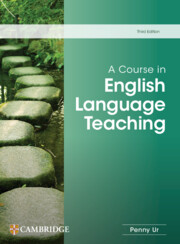Book contents
- Frontmatter
- Contents
- Acknowledgements
- Introduction
- 1 Teaching English today
- 2 The lesson
- 3 Classroom interaction
- 4 Tasks
- 5 Texts
- 6 Teaching vocabulary
- 7 Teaching grammar
- 8 Teaching listening
- 9 Teaching speaking
- 10 Teaching reading
- 11 Teaching writing
- 12 Feedback and error correction
- 13 Assessment and testing
- 14 The syllabus
- 15 Teaching/learning materials
- 16 Teaching content
- 17 Classroom discipline
- 18 Digital technology and online teaching
- 19 Learner differences 1: age
- 20 Learner differences 2: diversity and inclusion
- 21 Teacher development
- Glossary
- References
- Index
- Frontmatter
- Contents
- Acknowledgements
- Introduction
- 1 Teaching English today
- 2 The lesson
- 3 Classroom interaction
- 4 Tasks
- 5 Texts
- 6 Teaching vocabulary
- 7 Teaching grammar
- 8 Teaching listening
- 9 Teaching speaking
- 10 Teaching reading
- 11 Teaching writing
- 12 Feedback and error correction
- 13 Assessment and testing
- 14 The syllabus
- 15 Teaching/learning materials
- 16 Teaching content
- 17 Classroom discipline
- 18 Digital technology and online teaching
- 19 Learner differences 1: age
- 20 Learner differences 2: diversity and inclusion
- 21 Teacher development
- Glossary
- References
- Index
Summary
What is classroom discipline?
Classroom discipline can be defined as the situation that exists when teacher and students accept and consistently observe a set of rules relating to classroom behaviour in order to facilitate smooth and efficient teaching and learning. Many teacher-preparation courses avoid the term discipline – because it sounds rather old-fashioned and seems to imply an authoritarian classroom regime – and prefer to focus on classroom management: but they are not the same thing. Classroom management has to do with the way teachers organize the interactions that take place during a learning activity: how they run question-andanswer sessions, for example, how they move students in and out of group work, how they open and close lessons. It is important, but it is only one of the means through which classroom discipline, as defined above, can be achieved.
What does a disciplined classroom look like in practice? Here are some possible characteristics.
1 Learning is taking place.
2 It is quiet.
3 The teacher is in control.
4 The teacher and students are cooperating.
5 Students are motivated.
6 The lesson is proceeding according to plan.
7 The teacher and students are aiming for the same objectives.
If you do not wish to do the task shown in Pause for thought on the next page, then read on to the Comment below it.
Pause for thought
Which of the features listed on the previous page seem to you, in the light of your own experience as student or teacher, characteristics of a disciplined classroom? Do you have any reservations about any of them? Make a note of your responses, and then read on.
Comment
1 Learning is taking place. The question of the relationship between discipline and learning is crucial. It seems fairly clear that in a disciplined classroom, it is easier to activate students in the way you want, and that time will be probably spent on-task, rather than wasted on organizational problems or disruptive behaviour. However, I have seen well-disciplined classes in which little or no learning was taking place, simply because the tasks had themselves little learning value (see 4 Tasks). So a disciplined classroom does not, in itself, necessarily entail good learning.
- Type
- Chapter
- Information
- A Course in English Language Teaching , pp. 234 - 244Publisher: Cambridge University PressPrint publication year: 2024

